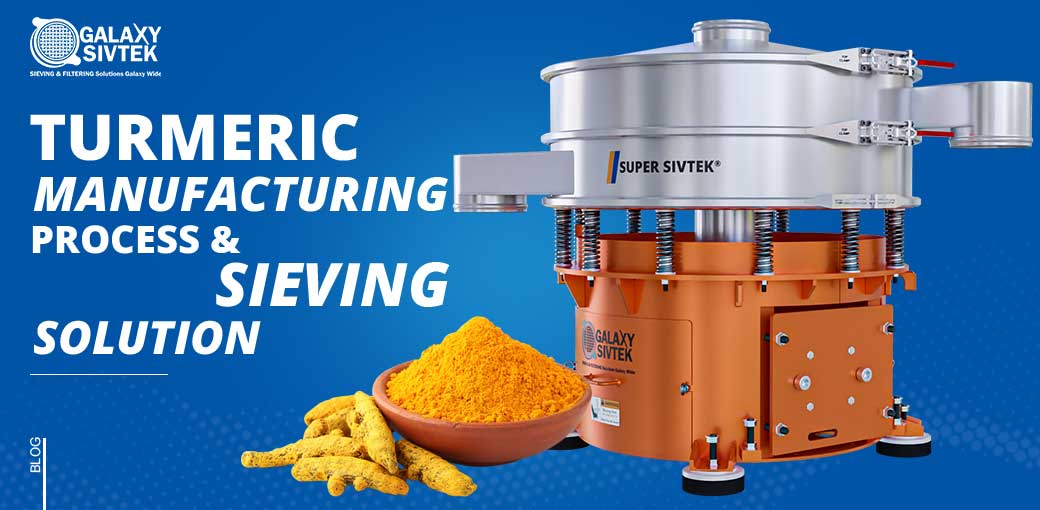
Committed To Quality, Committed To You
In this blog we will share facts, figures & process of how turmeric powder is made & where our sifting & sieving machines play role in their production process.
Turmeric (Curcuma Longa) belongs to ginger family & its native to tropical south Asia & India.
India is among the major producer of turmeric & its various products such as ground turmeric, turmeric oil & curry powder.
India alone exports 90% of turmeric to the world! Tamil Nadu, Andhra Pradesh, Orissa, West Bengal & Assam are among the major regions where turmeric is harvested & processed in abundance.
Not only India tops in producing turmeric, it also tops in consuming turmeric & its products. Almost 80% turmeric around the world is only consumed by Indians alone.
In India, turmeric has wide usage. It is not only used as spice in cooking, but is also used to cure various nominal flu & small viral infections like cold as it contain antibiotic value as per Indian ayurvedic beliefs. Apart from that, turmeric holds great sociocultural value as in India as it is used in many religious and marriage ceremonies.
Let us now know how “golden spice” – turmeric powder is made!
Cultivating & Harvesting
The process starts with cultivating & harvesting the flowering plant Curcuma Longa (of the ginger family)
Harvested turmeric goes trough series of washing to remove the adhering soil & mud. Roots are properly removed; the mothers & fingers are then separated.
Curing
Actual process starts with boiling fresh rhizomes and this process of boiling is called curing.
Under curing process clean rhizomes are placed in shallow pans in large iron vats; water is then added in a way where all the rhizomes are well dipped. Finally boiling is done for around 45 to 50 minutes.
Curing is done to remove raw odor, to make rhizomes soft, to reduce dying time & to obtain more uniform color.
Curing is considered as crucial process as it influences color & aroma of final product. Under-cooking renders the dried product brittle whereas over cooking spoils the color & aroma of final product.
Drying
So after perfect curing, the next step is drying the boiled & wet the rhizomes. Drying can be done naturally under the sun light or it could also be dried artificially.
Most of farmers & turmeric producers prefer natural drying process. Under this process, cooked turmeric fingers are dried in sun by spreading them on 5-7 cm thick layers of bamboo mats or on clean drying floors. It is important to dry rhizomes on clean surface in order to avoid contamination by any extraneous matters. Drying process usually takes to 10-15 days & to make sure fingers are dried sufficiently, few of them are break. If while breaking dried fingers metallic sound is generated, it is considered to be properly dried.
Polishing
Just after drying, the important process of polishing takes place. As the dried turmeric has dull surface color and a rough appearance, it is polished to improve its appearance by smoothing (polishing) outer surface.
Polishing can also be done in manually or mechanically. In manual polishing dried rhizomes are rubbed on hard surface, while in mechanical polishing dried turmeric is rotated in polishing drums.
Coloring
Coloring determines the pricing factor of final product. Sometimes dried rhizomes are coated with turmeric powder while it is being polished, this process is called dry coloring. The other way to colorize is by sprinkling turmeric powder mixed with little water during final phase of polishing; this process is called wet polishing.
The finished turmeric is then sent to spice manufacturing companies where they mill & grind dried turmeric to obtain ground turmeric.
Milling
In order to obtain turmeric powder, dried rhizomes are grounded to require size through process called milling. Dried rhizomes are grined to obtain its powder form.
Sieving & Packaging
Once turmeric is milled & grinded to powder form, the most important process is carried – process of sieving & screening.
Why sieving & screening is required? A small contamination can lead to hazardous consequences for the consumer & damage brand value severely. While processing turmeric chances of mud, dust or even nut bolt, screws, etc being passed along with product.
So to remove any such unwanted things, extraneous matters, lumps sieving & screening is required. Even to get fine & smooth powder, screening place vital role.
Even to obtain different market grades of turmeric powder sieving is done. The powder is designated coarse if 98% passes through a 500-um mesh sieve & fine if 98% passes through a 300-um mesh sieve.
Fine powder is highly valued in market.
In sieving process, the turmeric power is passed through mechanical sieves such as vibratory sieves (gyratory separators) before packaging to make sure final product is smooth & contamination free.
After sieving, it is finally labeled & packed to sell it in market.
Why our sieving machines?
Our sieving & check screening machines are
– Made from food grade materials and is corrosion free as made with high quality stainless steel (316 & 316L) with crevice free joints. (Turmeric power reacts with corrosion material as it contains moisture)
– Food grade rubber gaskets.
– As per guidelines & norms of regulatory bodies like The Food & Drug Administration (FDA) & Good Manufacturing Practice (GMP).
– Robust built up with certified parts like ATEX certified motors.
– Supple customer support.
– Easily retrofitted in existing processing lines.
